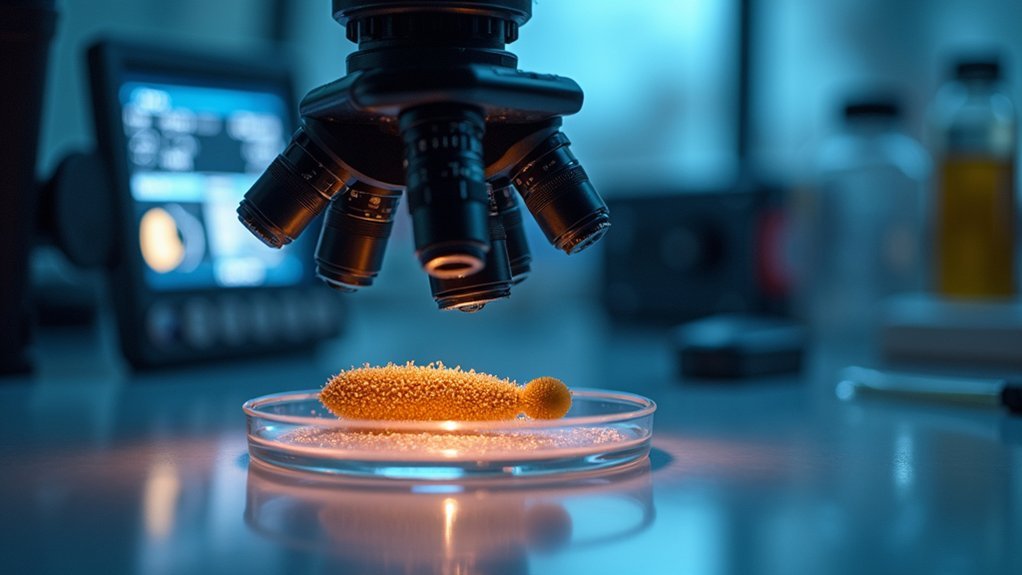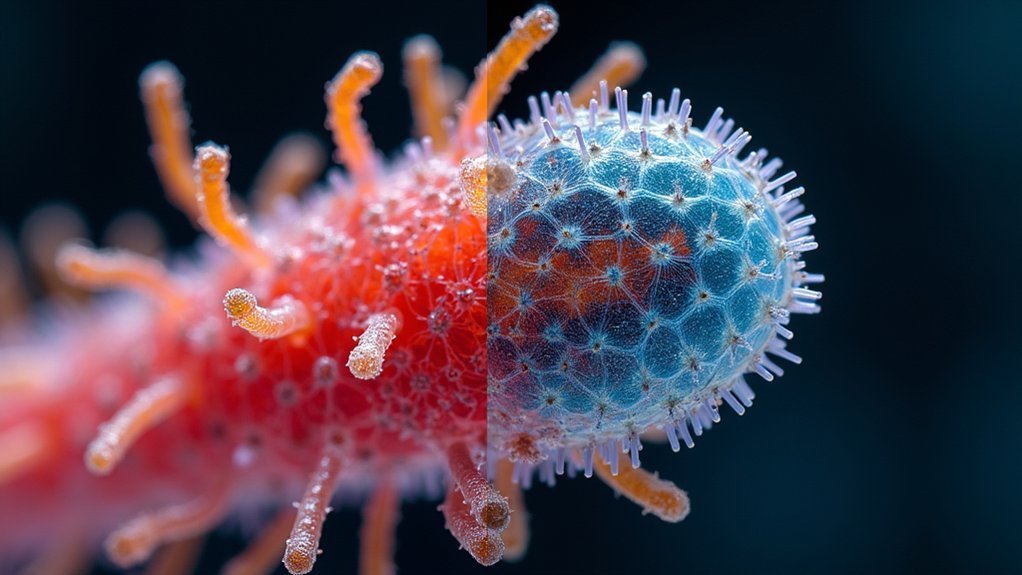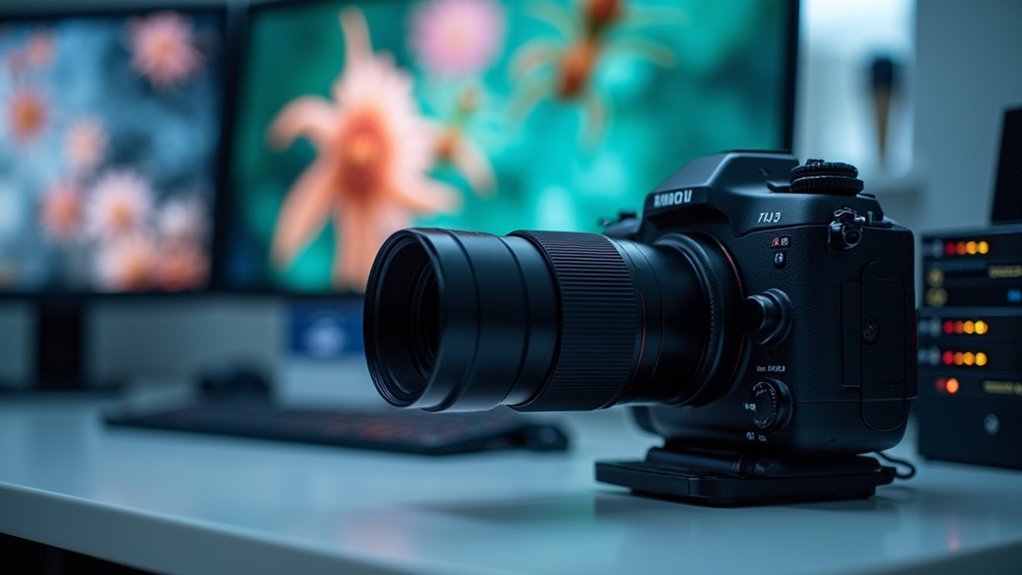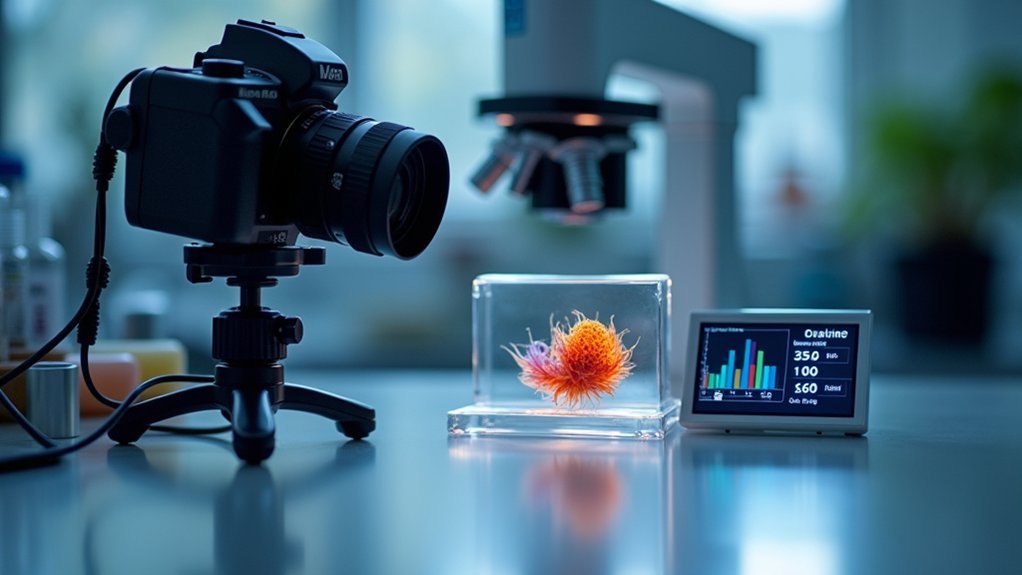For live specimen recording, choose your frame rate based on the subject’s movement speed. Use 30 FPS for standard documentation, 60 FPS for rapidly moving specimens, and 120 FPS when detailed slow-motion analysis is needed. Higher frame rates require better lighting, more storage, and increased processing power. You’ll need to balance resolution with frame rate—faster subjects need higher FPS while stationary specimens benefit from resolution. This balance creates ideal footage for scientific observation and analysis.
Numeric List of 13 Second-Level Headings

Thirteen critical considerations shape your choice of frame rate when recording live specimens.
When deciding between 30, 60, or 120 FPS, you’ll need to evaluate:
- Specimen Movement Speed
- Playback Requirements
- Hardware Capabilities
- Streaming Platform Compatibility
- Storage Constraints
- Lighting Conditions
- Post-Production Needs
- Video Playback Environment
- Resolution Trade-offs
- Bitrate Requirements
- Motion Blur Preferences
- High-Speed Analysis Needs
- Energy Consumption
Higher frame rates capture smoother motion but require more powerful equipment and storage.
For standard documentation, 30 FPS offers the best balance of quality and compatibility.
When analyzing rapid movements, 60 FPS provides better detail.
For specimens requiring slow-motion analysis, 120 FPS enables frame-by-frame examination that reveals otherwise invisible behaviors.
Understanding Frame Rate Fundamentals in Microscopy
Frame rate selection in microscopy directly impacts your ability to capture fluid biological movements, with higher FPS providing smoother motion representation in live specimen recordings.
You’ll need to balance between standard 30 FPS for general observations and elevated rates of 60+ FPS when documenting rapid cellular activities or microscopic behaviors.
Consider both your specimen’s movement speed and your equipment’s display capabilities when configuring ideal recording settings to make certain you’re capturing meaningful data rather than unnecessary digital bulk.
Microscopy Frame Rate Basics
When capturing the dynamic world of microscopic life, understanding frame rate fundamentals becomes essential for producing scientifically valuable recordings. Your frame rate choices directly impact how effectively you’ll document specimen behavior and cellular processes.
The standard frame rate of 30 FPS provides a balanced approach for most live imaging scenarios, giving you clear visualization of typical biological movements. For rapidly moving specimens, you’ll benefit from a high frame rate of 60 FPS or more, ensuring smooth playback and accurate motion representation.
When video is captured at higher frame rates, be aware that increased bitrates are necessary to maintain image quality, affecting your storage requirements. For slower-moving subjects, 24 FPS can offer a cinematic quality while conserving data resources during extended observation sessions.
Motion Capture Considerations
Selecting the ideal frame rate for microscopy requires careful attention to your specimen’s movement patterns and behaviors.
When capturing video footage of live specimens, you’ll need at least 30 FPS to effectively document fast movements without motion blur, guaranteeing smooth representation of biological processes.
For rapid cellular activities or quick-moving microorganisms, consider using 60 FPS, which provides more detailed motion capture during playback and enables clean slow-motion analysis.
Remember that higher frame rates increase file sizes and bandwidth requirements—your 60 FPS recordings will demand higher bitrates to maintain quality.
Always synchronize your chosen FPS with your display equipment’s capabilities to prevent motion perception discrepancies.
Adhering to standard scientific frame rates (30 or 60 FPS) also guarantees your footage remains compatible with common analysis protocols across research communities.
Optimal Recording Settings
Although many researchers focus primarily on magnification power, understanding frame rate fundamentals forms the backbone of successful microscopy recordings. When configuring your setup, the standard 30 FPS provides an ideal balance for most live specimen observations, delivering smooth motion without taxing your storage systems.
| Frame Rate | Best Application |
|---|---|
| 24 FPS | Less suitable for dynamic processes |
| 30 FPS | Standard for most specimen recording |
| 60 FPS | Fast-moving microorganisms |
| 120 FPS | Extremely rapid cellular activities |
| Custom | Specialized research requirements |
Your recorded specimen video quality depends on matching frame rates to both your subject’s movement speed and your display capabilities. Remember that proper lighting conditions work in tandem with your chosen frame rate—even the best frame rate won’t compensate for poor illumination or inadequate resolution settings.
The Science Behind Motion Capture in Live Specimens
The science of motion capture requires balancing frame rates to minimize motion blur while maximizing clarity, especially when you’re tracking fast-moving microorganisms that demand higher fps settings.
Your choice of frame rate should align with species-specific considerations—mammals typically record well at 60fps, while insects or single-cell organisms might require 120fps or higher for accurate behavioral analysis.
Understanding temporal resolution thresholds helps you determine the minimum frame rate needed to capture critical movements without missing key biological events that occur between frames.
Motion Blur vs. Clarity
When recording live specimens, understanding the relationship between motion blur and frame rate becomes critical to achieving ideal clarity. Motion blur occurs when your frame rate can’t keep pace with your subject’s movements, resulting in smudged, indistinct footage.
Higher frame rates directly improve your recording quality in several ways:
- Enhanced detail capture – 60 FPS recordings reveal fine structures even during fast motion
- Reduced motion blur – Quick movements appear crisp rather than smudged
- Slow-motion analysis – Higher frame rates allow you to slow footage while maintaining smoothness
- Improved tracking – You’ll better follow rapid movements like insect wing beats
While 30 FPS suffices for relatively stationary specimens, consider 60 FPS when documenting active organisms to strike the best balance between file size and clarity.
Species-Specific Frame Considerations
Different species demand tailored frame rates based on their unique movement patterns and biological characteristics.
When recording fast-moving insects or birds, you’ll need to exceed 60 FPS to avoid motion blur and capture their rapid actions with precision. These specimens simply move too quickly for standard frame rates to document effectively.
For fish or small mammals performing swift movements, consider 120-240 FPS, which allows for detailed slow-motion analysis while preserving critical behavioral data.
Meanwhile, slower-moving species may be adequately captured at 24 FPS, offering a cinematic quality while maintaining necessary clarity.
Remember that higher frame rates require stronger lighting conditions to maintain image quality.
You’ll need to balance your frame rate selection with the available light in diverse habitats to achieve ideal recording results.
Temporal Resolution Thresholds
Understanding temporal resolution thresholds provides the scientific foundation for effective specimen recording decisions.
When capturing live specimens, your frame rate choices directly impact the quality and scientific value of your recordings.
For ideal temporal resolution, consider these key thresholds:
- Minimum viability – 30 FPS captures basic movements without significant blur
- Natural perception – 60 FPS aligns with human visual processing, creating footage that appears smooth and natural
- High-speed events – 120+ FPS becomes essential when documenting rapid behaviors like bird flight or predator strikes
- Storage requirements – Higher frame rates generate substantially larger files, requiring more robust hardware for processing
Your selection should balance the temporal resolution needs of your specific specimen against practical limitations of your recording setup.
Standard Frame Rates for Different Biological Specimens
Although many researchers default to a single frame rate for all recordings, selecting the appropriate frame rate for your specific specimen is crucial for accurate documentation. Different biological specimens exhibit varying movement speeds that require tailored frame rates for ideal capture.
| Specimen Type | Recommended Frame Rate |
|---|---|
| Standard lab specimens | 30 FPS |
| Fast-moving organisms | 60 FPS |
| Slow cellular processes | 24 FPS |
| Motion analysis subjects | 120 FPS |
When recording standard laboratory specimens, you’ll find 30 FPS provides natural-looking footage while capturing most biological movements effectively. For fast-swimming fish or flying insects, increase to 60 FPS to guarantee smooth documentation of rapid motion. Remember that environmental factors and the specific behaviors you’re documenting should ultimately guide your frame rate selection.
Capturing Cellular Movement: Optimal FPS Settings

When observing the intricate dance of cellular movement, choosing the right frame rate can make the difference between capturing essential biological events and missing them entirely. Your FPS selection directly impacts video quality and data interpretation.
For ideal cellular movement recording, consider these settings:
- Standard observation: 30 FPS provides adequate detail for most cellular processes while maintaining reasonable file sizes.
- Dynamic processes: 60 FPS enhances clarity when tracking faster cellular movements.
- High-speed phenomena: 120+ FPS enables detailed slow-motion analysis of rapid events like mitosis.
- Technical balance: Match your FPS to your equipment capabilities, ensuring proper lighting and high-quality optics complement your frame rate.
Remember that higher frame rates require increased storage capacity but deliver superior temporal resolution for scientific analysis.
High-Speed Frame Rates for Rapid Biological Processes
Rapid biological processes that occur in milliseconds demand specialized recording techniques beyond standard frame rates. When you’re capturing fast biological events like insect flight or muscle contractions, you’ll need high-speed frame rates of 120 FPS or higher to reveal details invisible to the naked eye.
| Process Type | Recommended Frame Rate |
|---|---|
| Insect Flight | 240-1000 FPS |
| Muscle Contractions | 120-240 FPS |
| Cell Division | 60-120 FPS |
| Developmental Changes | 240+ FPS |
| Neurological Responses | 1000+ FPS |
Remember that higher frame rates require balancing resolution against data throughput. Most high-speed cameras capture short bursts at extreme frame rates, perfect for analyzing brief phenomena. For effective live specimen recording, choose your frame rate based on the specific biological process you’re studying.
Frame Rate vs. Resolution Trade-offs in Live Microscopy

Selecting the ideal frame rate for microscopy requires careful consideration of resolution trade-offs. When you’re streaming live microscopy footage, you’ll need to balance image quality with motion capture capabilities.
- Resolution vs. Motion: At 1080p, you might need to limit your frame rate to 30 FPS, while 720p allows for higher frame rates (60 FPS) with reduced data load.
- Bandwidth Requirements: Higher resolution with faster frame rates demands increased bitrates—about 9,000 Kbps for 1080p at 60 FPS.
- Display Limitations: Consider your viewers’ devices; higher frame rates won’t benefit users with standard 60Hz displays.
- Specimen Behavior: Match your video quality settings to specimen movement—fast-moving subjects benefit from higher frame rates, while stationary specimens gain more from increased resolution.
Hardware Requirements for Different Recording Rates
You’ll need substantial processing power when recording specimens at higher frame rates, with 60 FPS requiring roughly twice the computational resources of 30 FPS captures.
Your computer should feature a multi-core processor and dedicated graphics card to handle real-time encoding without dropping frames or overheating during extended recording sessions.
Storage requirements increase proportionally with frame rate, so plan for approximately 1.6GB per minute at 30 FPS (1080p) and 2.4GB per minute at 60 FPS, necessitating high-capacity SSDs or raid arrays for longer recording projects.
Processing Power Needs
When capturing live specimens at high frame rates, your hardware capabilities become a critical bottleneck that can make or break recording quality.
Your system needs sufficient processing power to handle the data demands of higher frame rates, especially at 60 fps which requires considerably more resources than 30 fps.
For ideal live streaming of specimens, verify your hardware can support:
- Minimum 4,500 Kbps bitrate for smooth 30 fps recordings
- Up to 9,000 Kbps bitrate when capturing at 60 fps to prevent pixelation
- Dedicated graphics card for processing high-resolution footage efficiently
- Fast CPU with adequate cooling to prevent thermal throttling during extended recording sessions
Older hardware will struggle with 4K at 60 fps, so you’ll need to balance frame rates and resolution based on your equipment’s capabilities.
Storage Capacity Requirements
While processing power guarantees smooth real-time recording, storage capacity becomes the next major consideration when capturing live specimens at high frame rates. As you increase from 30 fps to 60 fps, your storage needs nearly double—a 1080p recording at 60 fps requires about 9 GB per hour versus 4.5 GB at 30 fps.
| Resolution | 30 fps (GB/hr) | 60 fps (GB/hr) | Codec Impact |
|---|---|---|---|
| 1080p | 4.5 | 9 | H.265: 50% less |
| 2K | 9 | 18 | H.265: 50% less |
| 4K | 11.3 | 22.5 | H.265: 50% less |
| 6K | 25 | 50 | H.265: 50% less |
| 8K | 50 | 100 | H.265: 50% less |
Your choice of video formats greatly affects storage capacity requirements. Using HEVC (H.265) can halve your storage needs compared to H.264, making higher frame rates more manageable for long-term specimen documentation.
Lighting Considerations at Various Frame Rates

As frame rates increase during live specimen recording, your lighting requirements change greatly. Higher frame rates like 60 FPS demand significantly more light than lower rates such as 24 FPS to maintain image quality and prevent motion blur.
When recording specimens, adjust your lighting setup based on:
- Exposure time – At 60 FPS, use a 1/120 second shutter speed requiring brighter lighting.
- Natural light sources – These enhance color accuracy but need adjustment when switching frame rates.
- Slow-motion requirements – Higher frame rates need additional lighting to prevent underexposed footage.
- Color temperature consistency – Maintain consistent lighting temperature across different frame rates to preserve specimen’s true colors.
Remember that inadequate lighting at higher frame rates will result in grainy, noisy footage that compromises the scientific value of your recordings.
Post-Processing Techniques for Frame Rate Optimization
Beyond lighting considerations, your scientific footage requires proper post-processing to maximize frame rate benefits. When recording live specimens, verify your recording frame rate aligns with display frame rate to prevent synchronization issues.
| Technique | Purpose | Recommended For |
|---|---|---|
| Frame Blending | Smooths motion in low frame rates | 24fps → 30fps conversion |
| Interpolation | Creates connecting frames | Slow-motion effects |
| Frame Rate Conversion | Adjusts to target playback rate | Cinema to digital platform shifts |
| Bitrate Adjustment | Preserves video quality | All frame rate modifications |
| Motion Compensation | Reduces artifacts | High-detail specimen recordings |
You’ll achieve better results by shooting at higher frame rates (60-120fps) for slow-motion sequences. When using 24fps for cinematic effect, employ conversion tools to adapt to 30fps or 60fps for wider compatibility. Always maintain consistent bitrate during post-processing to preserve video quality throughout your workflow.
Storage and File Management for High FPS Recordings

When capturing high frame rate footage of live specimens, you’ll face significant storage challenges that require careful planning. High FPS recordings demand substantially higher bitrate settings—a 1080p video at 60fps can require up to 9,000 Kbps, dramatically increasing your storage needs.
To effectively manage these larger files:
- Use SSDs instead of traditional HDDs for faster data transfer speeds and more reliable performance.
- Implement a Constant Bit Rate (CBR) encoding method to maintain consistent file sizes and guarantee smooth playback.
- Organize your footage systematically by date and subject to streamline the editing workflow.
- Back up your recordings to multiple storage devices or cloud services regularly.
These file management strategies will help you handle the substantial storage requirements while maintaining efficient access to your valuable specimen recordings.
Species-Specific Frame Rate Recommendations
The right frame rate selection directly impacts your ability to capture authentic specimen behavior. When recording insects or birds, opt for 60 FPS to document their swift movements with clarity and precision in your video content.
For terrestrial animals, 30 FPS offers an ideal balance between quality footage and manageable file sizes.
Aquatic species benefit from 50 FPS, which effectively captures their fluid motions underwater.
If you’re working with slower-moving specimens like certain reptiles or plants, 24 FPS delivers cinematic quality while preserving essential details.
Remember that species-specific recording requires flexibility—adjust your frame rate according to the subject’s activity level and environmental conditions.
Temporal Analysis Methods Using Multiple Frame Rates
Strategic implementation of varied frame rates during specimen recording reveals powerful temporal analysis capabilities you won’t achieve with a single setting.
When you switch between higher frame rate and low frame rate options, you’ll capture the complete behavioral spectrum of your specimens.
Consider these temporal analysis approaches:
- Utilize 60 fps for rapid movements to greatly reduce motion blur and capture crisp details.
- Switch to 24 fps for slower, more static observations to create cinematic quality while maintaining clarity.
- Adapt frame rates in real-time as specimen behavior changes to guarantee ideal documentation.
- Leverage higher frame rates for post-production slow-motion analysis, revealing subtle interactions invisible to the naked eye.
This adaptive approach guarantees you’ll document both dramatic movements and nuanced behaviors with scientific precision.
Frequently Asked Questions
What Is a Good FPS for Video Recording?
For video recording, you’ll want 30 FPS for standard situations or 60 FPS for fast-moving subjects. You can use 24 FPS for cinematic projects, though it won’t capture motion details as effectively.
What Is the Frame Rate for Live Video?
For live video, you’ll want a minimum of 30 FPS, though 60 FPS is ideal for smoother motion. Your choice should match both your content’s pace and your display device’s capabilities for peak streaming quality.
Should I Record at 60 or 120 FPS?
Record at 60 FPS for most live specimen needs – it’s sufficient and manageable. Choose 120 FPS only if you’re capturing high-speed movements or need detailed slow-motion analysis. Consider your storage capacity and playback requirements.
Should I Record at 30FPS or 60FPS?
Choose 60fps for fast-moving specimens where you’ll need smooth slow-motion analysis. Use 30fps if you’re recording slower subjects or need to save storage space for longer recording sessions.
In Summary
You’ll find that selecting the right frame rate transforms your live specimen recordings from merely capturing movement to revealing scientific insights. By matching FPS to your specimen’s activity level, research objectives, and storage capabilities, you’re optimizing both data quality and workflow efficiency. Remember, there’s no universal perfect frame rate—your specific research context will determine whether you’ll need 30 fps or 1000+ fps.





Leave a Reply